- What is a Recommendation System and Why It Matters for Businesses
- How Does Recommendation Systems Work?
- Data Processing
- Learning User Preferences
- Generating Recommendations
- Updating Recommendations
- Real Example: Netflix
- Features of Developing a Recommendation System
- User Profiles
- Search and Filtering Options
- Recommendation Widgets
- Notifications and Alerts
- Feedback Mechanisms
- Wishlist/Favorites
- Social Sharing
- Multi-Platform Experience
- User History Tracking
- Login and Authentication
- Advanced Features/Functionalities of a Robust Recommendation System
- Personalized Content Delivery
- Data Collection
- Data Analysis
- Generating Recommendations
- Updating Models
- Delivering Recommendations
- Monitoring User Interactions
- Handling Multilingual Content
- How to Build a Recommendation System: A Step-by-Step Process
- Step 1: Define the Objective
- Step 2: Gather and Prepare Data
- Step 3: Choose the Algorithm
- Step 4: Develop the Model
- Step 5: Test the System
- Step 6: Deploy the System
- Step 7: Monitor and Update
- Step 8: Analyze and Iterate
- Cost of Building a Recommendation Engine
- Factors Affecting the Cost to Build a Recommendation System
- Data Complexity and Volume
- Algorithm Complexity
- System Integration
- Maintenance and Updates
- Expertise of the Hired Development Team
- Customization Requirements
- Real-time Processing Needs
- Scalability Requirements
- Compliance and Security
- Localization Needs
- How To Build a Recommendation System That Stands Out From the Competition (Future Ready Features)
- What the Future Holds for AI-powered Recommendation Systems
- Increased Personalization
- Integration with Emerging Technologies
- Enhanced AI Capabilities
- Greater Focus on Privacy and Security
- Cross-Domain Recommendations
- Decentralization
- Why Appinventiv is the Right Partner for Developing a Robust Recommendation System
- FAQs
As a business owner in 2025, you must know that personalization is the secret sauce of modern digital interactions. Your consumers are drawn to tailor-made experiences, whether choosing a new product, streaming a show, or browsing various services.
This high level of personalization comes from advanced tools known as recommendation systems. These systems elevate the personalized experience, making every online interaction feel specially curated for each user. This not only keeps users hooked but also drives up sales and has a direct impact on your Return on Investment (ROI).
Recommendation systems are at the core of many digital triumphs achieved by many applications. Think of the seamless, customized suggestions you see on Amazon or Netflix; these are all powered by recommendation systems that analyze vast amounts of data to predict what catches your interest. These systems enhance user engagement and satisfaction by determining what users will likely want next. This means your business can do more than meet needs; it can create a lasting bond with customers.
To say the least, recommendation systems are indispensable for businesses today. They influence various strategies, from marketing to inventory management, helping you make informed decisions that keep customers from leaving and encourage them to spend more. Utilizing these systems means your business is not just reacting to trends but anticipating customer needs, leading to smarter investments and better outcomes.
Various e-commerce platforms or OTTs utilize machine learning to power their recommender system by analyzing vast amounts of user data, like viewing or shopping history, ratings, search behavior, and time spent on the platform, to generate personalized recommendations for each individual.
This blog will focus on how to build a recommendation system, its cost, and features. You will learn how they are developed, what it typically costs to implement them, and the key features that set them apart. Whether you’re tech-savvy, aiming to boost your business strategy, or just curious about how these systems operate to make digital platforms incredibly user-friendly, this blog will provide a clear and practical guide to understanding the vital aspects of recommendation systems in the digital landscape of 2025.
Boost bookings & revenue with a custom recommendation system.
What is a Recommendation System and Why It Matters for Businesses
Before jumping into how to build a recommender system, you first need to understand what it is.
A recommendation system is a type of data filtering tool that uses algorithms and data analysis to provide personalized suggestions to users. These systems collect and analyze data from user interactions, preferences, and other relevant metrics to predict and recommend products, services, or content that individual users are likely to be interested in.
From online shopping to streaming platforms, recommendation systems are integral in creating personalized experiences that help users navigate vast options more efficiently.
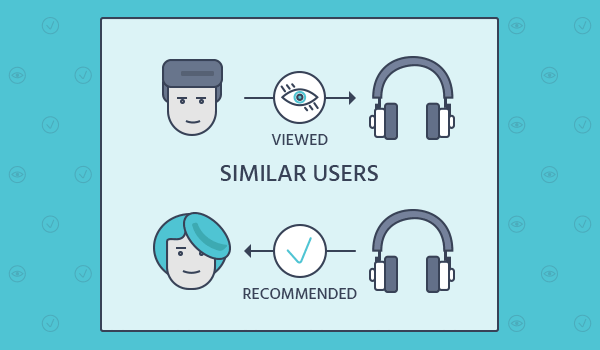
- These systems are crucial for businesses because they directly influence customer engagement and satisfaction. By delivering tailored suggestions, businesses can increase the likelihood of users taking action, such as purchasing or watching a show.
- This targeted approach improves user experience, drives higher conversion rates, and boosts sales. Additionally, by analyzing user behavior and preferences, these systems help businesses better understand their customers, allowing them to effectively refine their marketing strategies and product offerings.
Before businesses can leverage recommendation systems effectively, it’s essential to understand the different types of recommendation systems. Each type of system has its unique method of analyzing data and making recommendations, which can serve various business needs and goals.
| Types of Recommendation Systems | Description | Common Use Cases |
|---|---|---|
| Collaborative Filtering | Analyzes past interactions between users and items to identify and recommend items that similar users have liked. | E-commerce, streaming services |
| Content-Based | Recommends items similar to those a user has liked based on specific item features. | News feeds, music streaming |
| Hybrid Systems | Combines both collaborative and content-based methods to enhance recommendation accuracy and relevance. | Personalized marketing, integrated media platforms |
| Knowledge-Based | Uses explicit knowledge about items and user preferences when user-item interactions are limited. | Real estate, luxury goods |
| Demographic-Based | Makes recommendations based on demographic similarities among users rather than their past behavior. | Targeted advertising, regional promotions |
How Does Recommendation Systems Work?
Recommendation systems analyze large amounts of data to predict and suggest items users might like based on their preferences and behaviors. The process involves several steps and utilizes various data sources to ensure the recommendations are as accurate and personalized as possible. Let’s take a look at how these systems typically operate:

Data Processing
Once data is collected, it needs to be processed and organized. This might involve cleaning the data and transforming it into a format the recommendation system can use, such as converting text reviews into numerical data or categorizing items into different groups.
Learning User Preferences
The essential aspect of how to build a recommendation system is learning what users prefer. This can be done in several ways:
Collaborative filtering: This method makes recommendations based on the behavior of groups of users. If User A likes items 1, 2, and 3 and User B likes items 2, 3, and 4, the system might recommend item 4 to User A since similar users liked it.
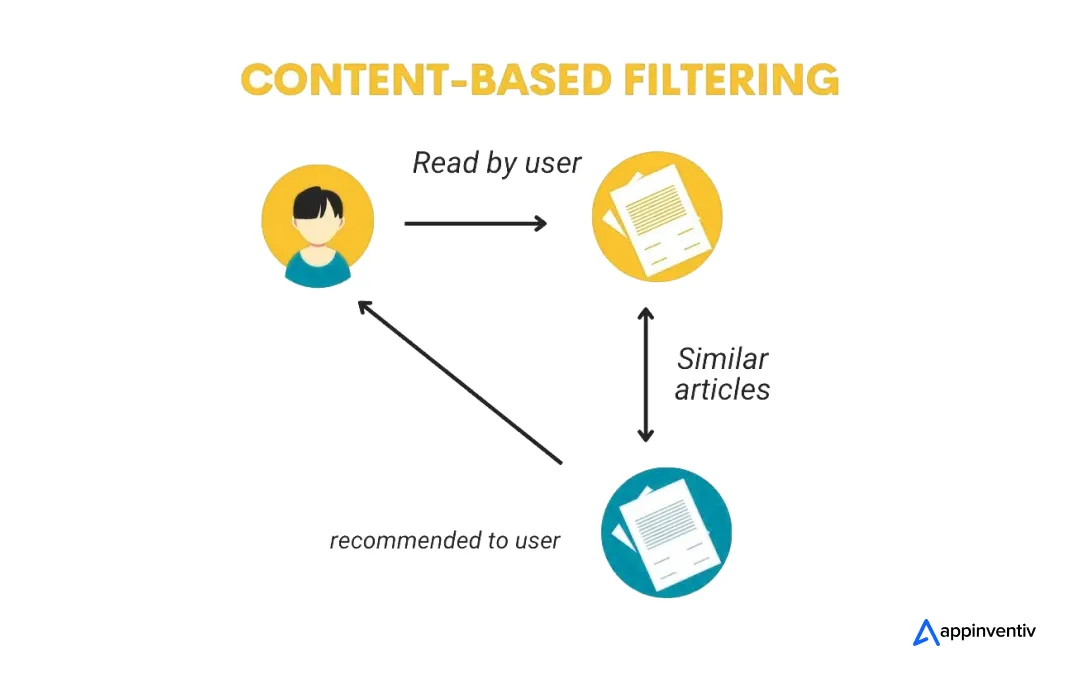
Content-based filtering: This approach uses features of the items to make recommendations. If a user likes science fiction movies with certain actors or directed by certain directors, the system will recommend other movies that share these features.
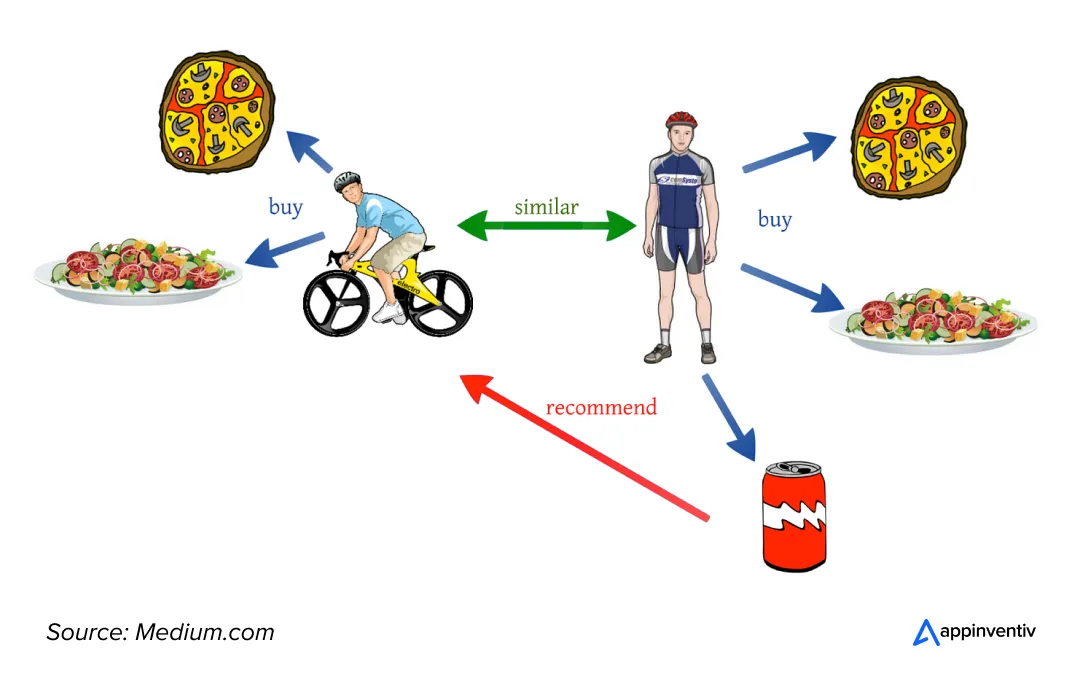
Hybrid methods: Many systems combine multiple techniques to improve the accuracy and relevance of their recommendations.
Generating Recommendations
The system generates a list of recommended items using the preferences learned in the previous step. This usually involves scoring each potential item based on how well it matches the user’s preferences and selecting the items with the highest scores.
Updating Recommendations
Recommendation systems are dynamic and continually update themselves as they receive more data about user preferences. As users interact with the system by viewing, purchasing, or rating items, the system refines its understanding of their likes and dislikes, making the recommendations even more accurate.
Real Example: Netflix
For example, Netflix recommends movies and shows to its users by leveraging a complex multi-task model that processes diverse data inputs and user interactions. Their system fine-tunes recommendations by adapting to real-time user feedback and viewing habits.
Netflix’s infrastructure supports this by running these models on a flexible online inference pipeline, accommodating different environmental needs such as latency and data freshness. These recommendations are then seamlessly delivered across various devices via a unified API, ensuring users receive personalized content suggestions that enhance their viewing experience.
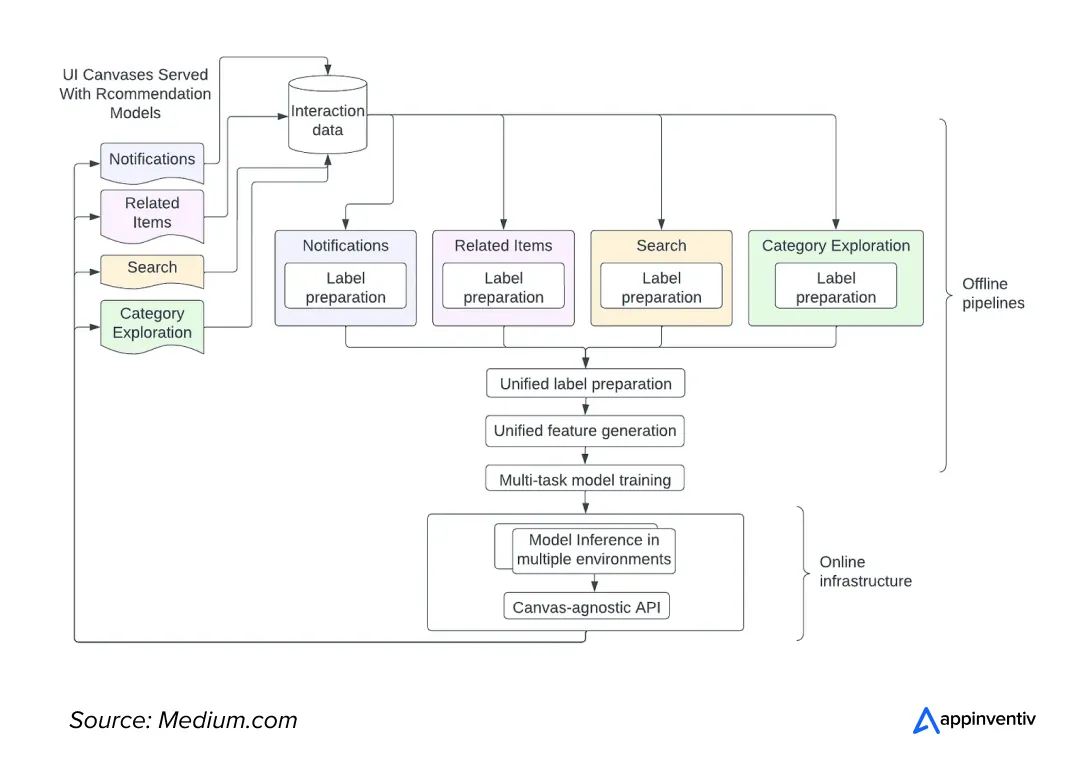
Features of Developing a Recommendation System
When defining the features of a recommendation system, it’s important to focus on specific elements that enhance the user interface and operational aspects. Let’s look into a concise breakdown of practical features within such systems before jumping into how to build a recommender system.
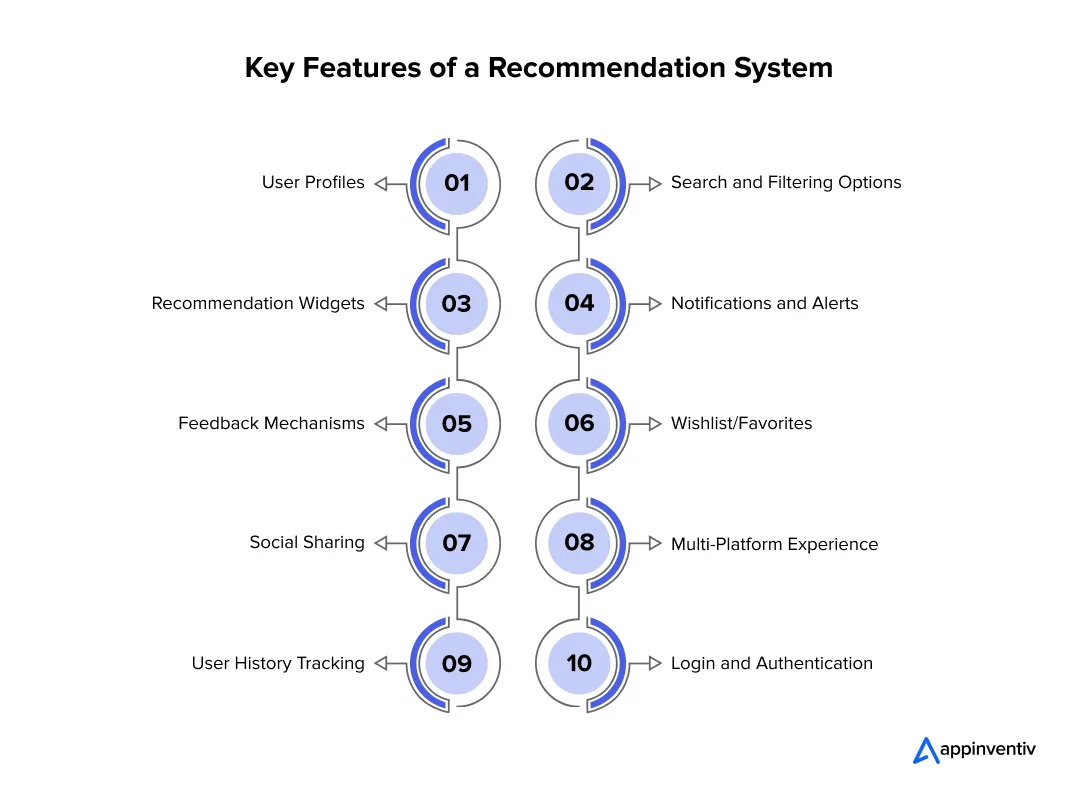
User Profiles
User Profiles allow users to create and customize their profiles, which the system uses to store preferences, browsing history, and feedback. This personal data is critical in curating personalized recommendations.
Search and Filtering Options
They enable users to efficiently navigate through large inventories by specifying criteria, which helps refine the system’s recommendations.
Recommendation Widgets
Recommendation Widgets are interactive components embedded in websites or apps that display personalized suggestions. These can vary from “Users who viewed this also viewed…” to “Recommended for you” panels.
Notifications and Alerts
They inform users about new items, special promotions, or updates related to their interests or previous interactions, keeping them engaged with the platform.
Feedback Mechanisms
Mechanisms for feedback, such as rating systems, like/dislike buttons, and review forms, allow users to provide direct feedback on recommendations, which the system can use to refine future suggestions.
Wishlist/Favorites
These features enable users to save items they are interested in, which can later influence the type of content or products the system recommends.
Social Sharing
These functionalities allow users to share their favorite items or recommendations with others via social media platforms, which can also provide the system with additional data points to refine its suggestions.
Multi-Platform Experience
Multi-Platform Experience ensures that users receive consistent recommendations and user experience across all devices and platforms, from desktops to mobile apps.
User History Tracking
User History Tracking records all user interactions, such as viewed items, purchases, and searches, which is crucial for making accurate recommendations.
Login and Authentication
Login and authentication processes are crucial for protecting user data and personalizing their experience while maintaining privacy and security.
Advanced Features/Functionalities of a Robust Recommendation System
Understanding the functionalities of a robust AI-based recommendation system helps appreciate how these features translate into tangible benefits for users and businesses. Here’s a breakdown of the key functionalities that these systems provide:
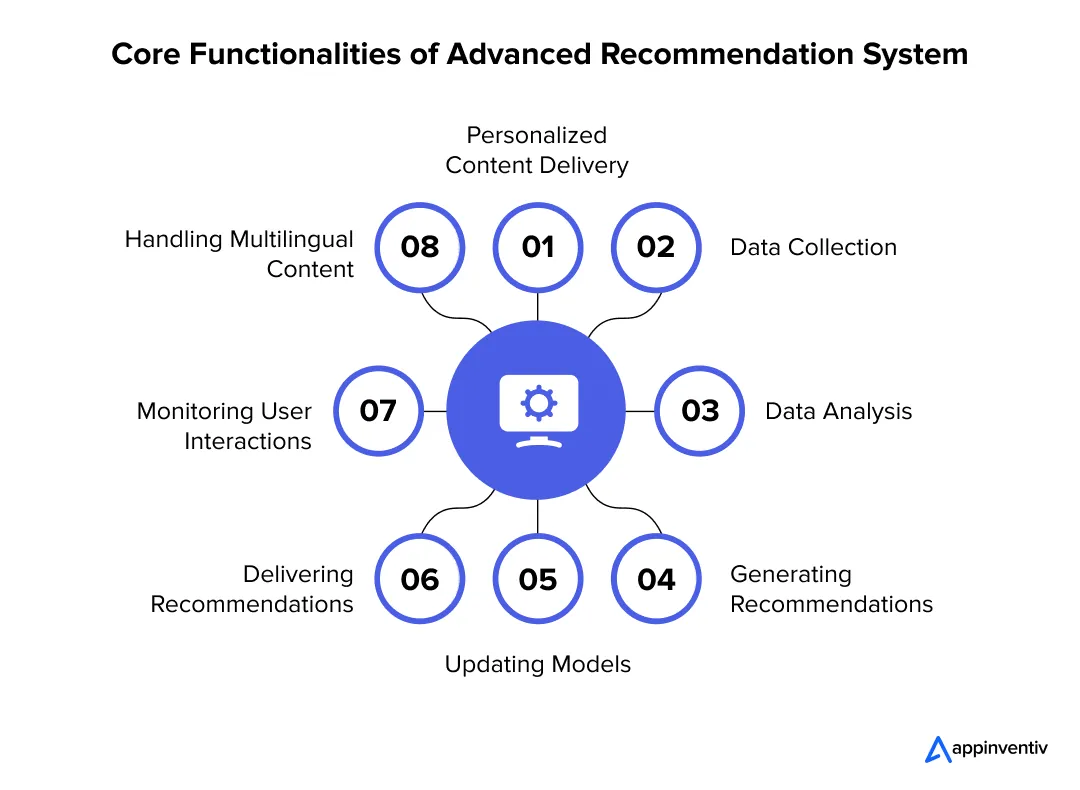
Personalized Content Delivery
The primary functionality of any recommendation system is personalized content delivery. Recommendation systems use algorithms to analyze user data and behavior to tailor content, products, or services to individual preferences. This ensures that users see more of what they like, which increases user engagement and satisfaction.
Data Collection
This involves gathering data from various sources, such as user behavior, browsing history, purchasing patterns, and preferences. The system continuously collects this data to inform its recommendation algorithms.
Data Analysis
The system processes and analyzes the collected data to identify patterns, trends, and user preferences. This analysis forms the basis for all recommendations made by the system.
Generating Recommendations
Based on the analysis, the system generates personalized recommendations for each user. This involves calculating prediction scores for various items and determining which items most likely interest the user.
Updating Models
The system updates its recommendation models in real-time or in batch processes to incorporate new data and feedback. This ensures that the recommendations remain relevant and accurate over time.
Delivering Recommendations
This is the process by which the system presents its recommendations to users, typically through user interfaces such as websites, apps, or emails. The delivery mechanism is designed to be seamless and integrated into the user experience.
Monitoring User Interactions
The system tracks how users interact with its recommendations, including clicks, purchases, likes, and dismissals. This monitoring helps further refine and optimize the recommendation algorithms.
Handling Multilingual Content
The system supports multiple languages for global platforms, allowing it to serve personalized recommendations to users in their preferred language and based on culturally relevant data.
These functionalities are the technical and operational tasks that a recommendation system can perform. They directly contribute to making these systems effective tools for personalization and engagement. The benefits of a recommendation system can significantly transform how businesses interact with their customers by enhancing user satisfaction, driving engagement, and increasing sales. Let’s take a brief look at them below:
| Benefits of Using Recommendation Systems | How Does It Matter? |
|---|---|
| Increased User Engagement | Users are likelier to stay engaged with a platform that offers personalized, relevant content. |
| Higher Conversion Rates | Personalized recommendations are more effective at converting browsing into purchases. |
| Enhanced User Satisfaction | These systems improve the overall user experience by providing relevant content and products. |
| Increased Sales | Tailored recommendations encourage users to make more purchases, boosting overall sales. |
| Improved Customer Retention | Satisfied users are more likely to return, leading to higher retention rates. |
| Efficient Marketing | By understanding user preferences, businesses can target their marketing efforts more effectively. |
| Data-Driven Insights | Recommendation systems provide valuable insights into customer behavior, preferences, and trends. |
| Global Reach | Multilingual support and adaptation to regional preferences expand the market reach of businesses. |
How to Build a Recommendation System: A Step-by-Step Process
Building a recommendation engine is a strategic process that involves understanding user data, leveraging machine learning algorithms, and continuously refining the system based on user interactions. This process is critical for businesses looking to enhance personalization and improve user engagement through targeted content and product suggestions. Here’s a step-by-step guide on how to build a recommender system.
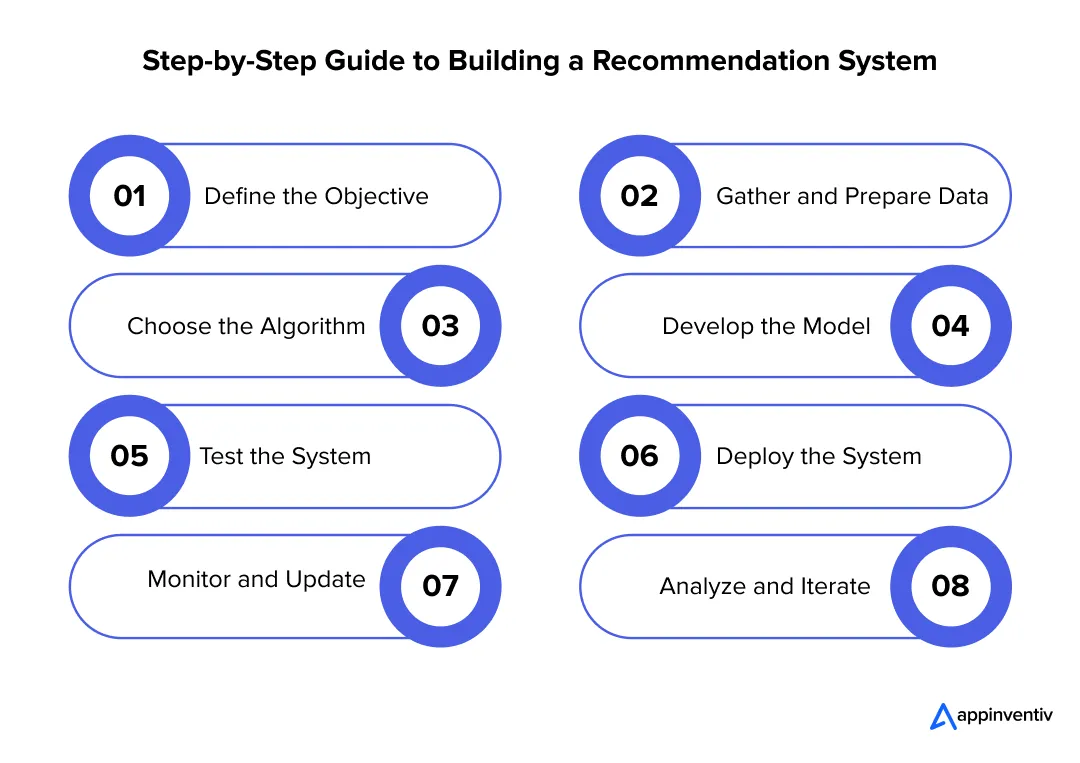
Step 1: Define the Objective
Before diving into the technical aspects, it’s crucial to clearly define what you want your recommendation system to achieve. Are you focusing on increasing sales, improving user engagement, or maybe enhancing content discovery? Your objectives will guide the design and functionality of your system.
Step 2: Gather and Prepare Data
Collect the necessary data that will feed into your recommendation system. This includes user data such as past purchases, browsing history, ratings, etc., and information about the items like their descriptions, categories, and tags. The data needs to be cleaned and processed to ensure it is consistent and usable, removing any inaccuracies or incomplete information.
Step 3: Choose the Algorithm
During this step of the process to build a recommendation system, select the appropriate algorithm based on your objectives and the type of data available. The most common types include:
- Collaborative filtering: This algorithm makes recommendations based on the collective preferences of other users with similar interests.
- Content-based filtering: This focuses on the properties of the items themselves, recommending similar items based on a user’s past preferences.
- Hybrid approaches: Combining both collaborative and content-based methods can often yield more accurate and relevant recommendations.
[Also Read: 5 Essential Machine Learning Algorithms Transforming Business Operations]
Step 4: Develop the Model
Using the selected algorithm, develop the recommendation model. This involves training the model with your data, tuning the parameters to optimize performance, and validating the model to ensure it predicts user preferences accurately. Machine learning frameworks like TensorFlow or PyTorch can be used to build and train sophisticated models.
Step 5: Test the System
Once your model is built, it’s important to test it thoroughly to check its effectiveness. Implement A/B testing by providing different sets of recommendations to various user groups and measuring the performance based on your objectives. This testing phase can help identify any adjustments needed in the algorithm or data handling.
Step 6: Deploy the System
After testing and final tweaks, deploy your recommendation system into your production environment, where it can start providing value to users. Ensure that the system integrates smoothly with your existing platforms and user interfaces.
Step 7: Monitor and Update
The launch of your recommendation system is just the beginning. Continuous monitoring is essential to ensure the system performs well and stays relevant. Regularly update the system with new data and refine the algorithm to adapt to changing user behaviors or business goals.
Step 8: Analyze and Iterate
Collect feedback and analyze how well the recommendation system meets the initial objectives. Use insights from user interactions and system performance to make iterative improvements. This ongoing process helps maintain the effectiveness of your recommendation system over time.
After having a clear understanding of how to build a recommendation system, let’s move ahead and look at the cost to develop a recommender system. .
Let’s make it not just functional but phenomenal!
Cost of Building a Recommendation Engine
Building a recommendation engine can vary widely in cost, typically ranging from a few thousand dollars for simpler systems to several hundred thousand or even millions for complex, enterprise-level solutions.
For a mid-sized project with moderate complexity, the costs could generally range between $100,000 to $300,000 or more. The total cost ultimately depends on several factors, including the complexity of the algorithms, the scale of data processing, and the specific business needs.
A basic formula to estimate the cost of building a recommendation system is:
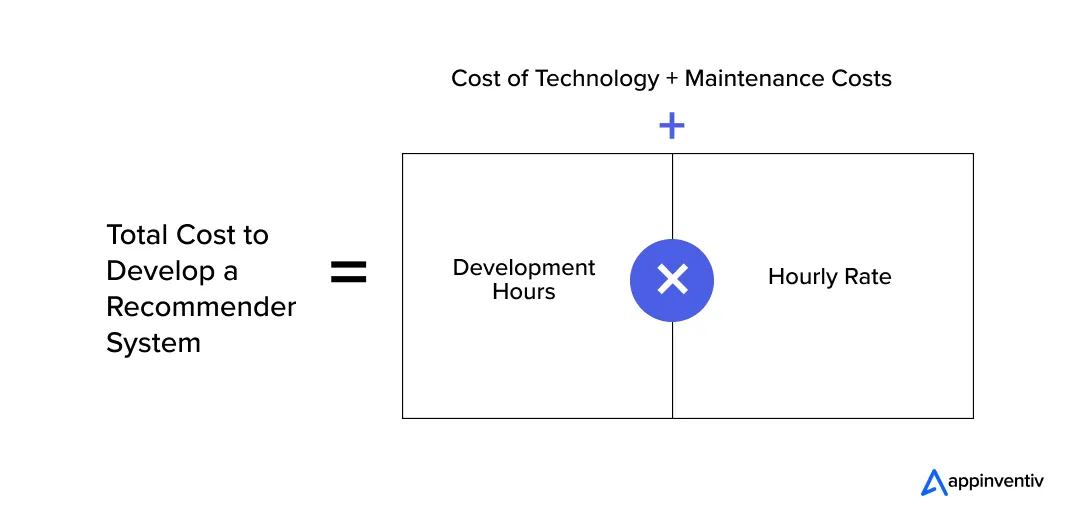
This formula can help estimate the initial development cost and should be adjusted to include ongoing expenses such as system maintenance and updates.
To provide a clearer picture of potential costs, let’s look at the typical activities involved in the development of a recommendation system, along with their estimated timeframes and expenses:
| Activity | Timeframe | Estimated Cost |
|---|---|---|
| Data Collection | 1-3 months | $5,000 – $20,000 |
| Data Cleaning and Preparation | 1-2 months | $10,000 – $30,000 |
| Algorithm Selection | 1 month | $3,000 – $10,000 |
| Model Development | 2-4 months | $20,000 – $50,000 |
| System Testing and Optimization | 2-3 months | $15,000 – $40,000 |
| System Integration | 1-3 months | $10,000 – $25,000 |
| Training and Deployment | 1-2 months | $5,000 – $20,000 |
| Ongoing Maintenance | Per year | $10,000 – $30,000 |
Now, multiple factors impact the overall cost of developing a recommendation system; let us look at them in detail below.
Factors Affecting the Cost to Build a Recommendation System
Several factors are crucial in determining the cost of building a recommendation system. These factors are directly tied to the complexity of the project, the resources required, and the long-term maintenance of the system. Let’s explore these factors to understand how they affect the overall cost.
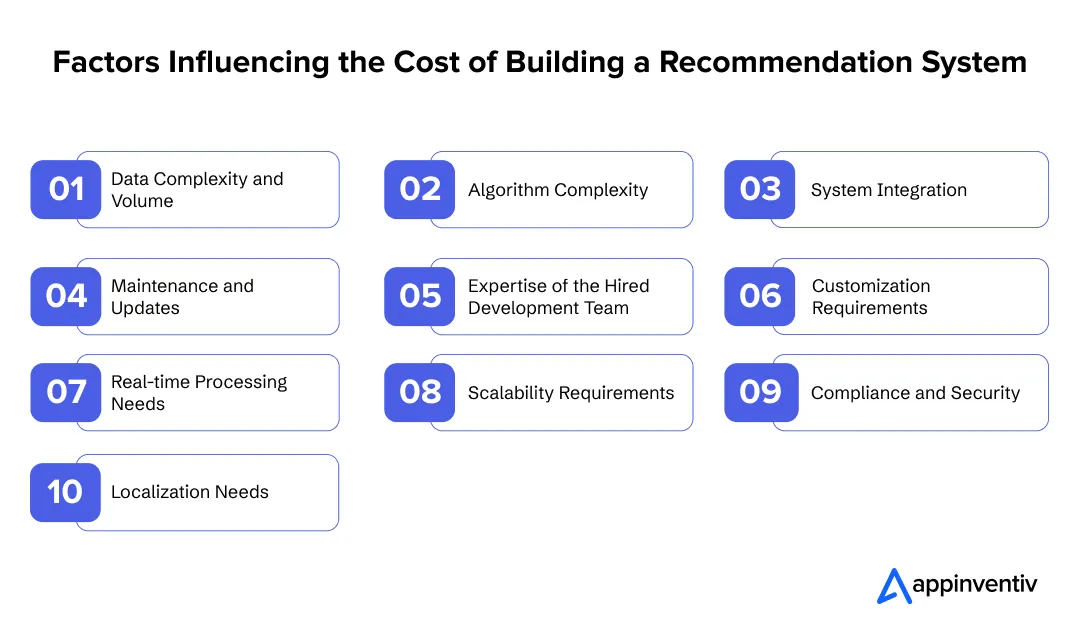
Data Complexity and Volume
The size and complexity of the data are major cost drivers. Larger datasets require more storage, advanced processing capabilities, and computational resources to analyze effectively. Additionally, if the data is unstructured or comes from diverse sources, extra steps may be required for cleaning, organizing, and standardizing. This increases both the time and resources needed, pushing up the cost.
Algorithm Complexity
Algorithms are the main aspect that impact the process of building a recommendation system and its costs. The choice of algorithm has a significant impact on the price. Standard algorithms, like collaborative or content-based filtering, are more cost-efficient as they are widely available and require less customization. However, if your system requires advanced techniques, such as deep learning models or hybrid approaches, it will involve higher development effort and computing power, driving costs upward.
System Integration
Integrating the recommendation system with your IT infrastructure, databases, and third-party platforms can add complexity. Seamless integration often requires custom API development, middleware, and data pipeline development, which require time and specialized skills. The more intricate the integration requirements, the higher the costs.
Maintenance and Updates
A recommendation system isn’t a one-time investment; it requires regular maintenance to stay relevant. Maintenance involves updating algorithms, fine-tuning recommendation system models, and ensuring compatibility with new technologies. Adding new data sources or features increases ongoing costs, especially as user needs and business goals evolve.
Expertise of the Hired Development Team
The expertise of the team building the system is another key factor. Experienced data scientists, machine learning engineers, and developers command higher salaries. Moreover, niche requirements like knowledge of specific frameworks can further elevate labor costs.
Customization Requirements
Custom development will be required if your business needs unique features or capabilities that standard recommendation systems don’t provide. Customization often involves significant effort, from designing algorithms to creating tailored user interfaces, which can substantially increase costs.
Real-time Processing Needs
Real-time processing needs also impact the overall recommendation software development costs. If your system needs to provide instant recommendations, it requires advanced architecture for real-time data processing. Real-time capabilities demand faster computation, higher bandwidth, and optimized data pipelines, all of which add to the expense.
Scalability Requirements
Scalability becomes a critical consideration if the recommendation system is expected to handle a growing number of users, products, or data sources. Building a scalable system involves designing infrastructure that can expand without compromising performance, which adds complexity and cost.
Compliance and Security
Ensuring the system complies with data privacy regulations like GDPR or CCPA adds to the cost. Implementing robust security measures like encryption and secure access protocols increases development and maintenance expenses.
Localization Needs
Adapting the recommendation system for different languages, cultural preferences, and regional behaviors for businesses targeting a global audience adds complexity. Localization involves modifying algorithms, interfaces, and content, which can be resource-intensive.
How To Build a Recommendation System That Stands Out From the Competition (Future Ready Features)
In today’s digital landscape, some recommendation system examples include giants like Netflix, which dominates streaming with highly personalized content recommendations, and Amazon, which leads e-commerce with its precision targeting of consumer preferences, which stands out as a formidable challenge. These industry leaders have set high standards for how recommendation systems can drive user engagement and sales.
To make your recommendation system truly competitive, it’s crucial to focus on key areas where improvements can be made or unique features can be introduced. Let us look at how to build a recommender system that stands out with extraordinary features.
| Feature | Current Implementation | Proposed Enhancement | Competitive Advantage | Impact on User Experience |
|---|---|---|---|---|
| Personalization Depth | Basic user preference tracking | Use more advanced deep learning to understand each user better | Go beyond competitors like Amazon in understanding user details | Increase user loyalty with very relevant recommendations |
| Real-time Adaptability | Updates recommendations daily | Update recommendations instantly based on user actions | Be faster than other recommendation system examples like Netflix while responding to users | Provide immediate satisfaction and relevance to users |
| Multimedia Integration | Text-based recommendations | Add video, audio, and interactive elements | Provide a richer, more varied experience than others | Keep users engaged longer and interacting more with the platform |
| Cross-platform Consistency | Different experiences across devices | Make sure the experience is the same on all devices | Provide a smoother user experience than competitors like Spotify | Make using different devices easier and less frustrating for users |
| Privacy Protection | Basic encryption | Add high-level privacy features like differential privacy | Be a leader in privacy and gain user trust, doing better than platforms like Facebook | Make users feel safer sharing personal data |
| Algorithm Transparency | Black-box models | Explain why certain recommendations are made | Stand out from services like YouTube by building trust | Make users feel more confident about the reliability of the system |
| Local and Cultural Relevance | General recommendations | Customize content for local tastes and cultural preferences | Offer better-localized content than global competitors | Draw in more users from niche and regional markets |
| Interactive Feedback | Basic feedback mechanisms | Use interactive, conversational feedback interfaces | Engage users more deeply than competitors like Instagram | Help refine the accuracy of recommendations and keep users interested |
| Scalability | Limited regional reach | Grow into new markets with a system designed to scale | Expand access more than global competitors | Reach a larger audience, increasing market presence |
| Innovative Technologies | Standard algorithms | Include the latest AI technologies like GANs or reinforcement learning | Lead in tech innovation, staying ahead of companies like Google | Spark interest and encourage new users through cutting-edge technology |
What the Future Holds for AI-powered Recommendation Systems
As technology advances, the future of recommendation systems looks set to transform business-to-customer interactions deeply. These systems will likely become more ingrained in everyday activities, influencing shopping, entertainment, and areas like education and healthcare. Here’s a brief look at potential developments that will revolutionize the future of the recommender system.
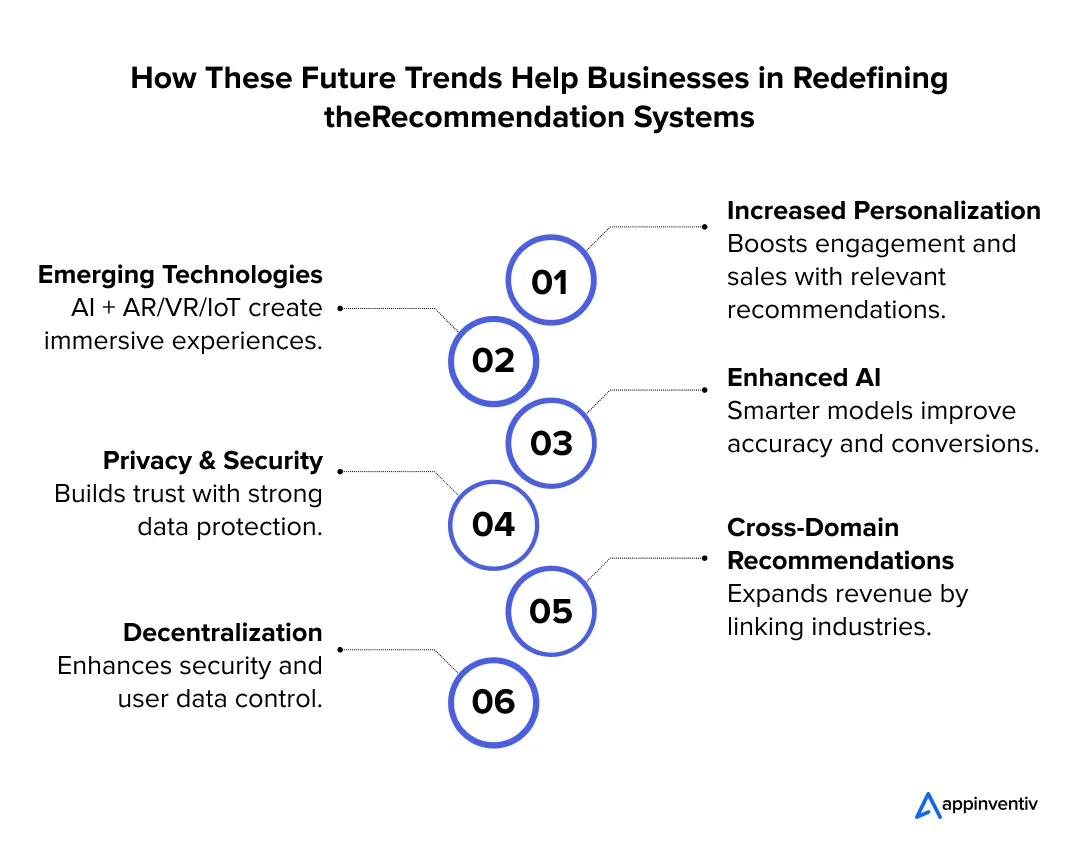
Increased Personalization
Future systems will utilize more diverse data sources, including biometrics and environmental context, to offer ultra-personalized experiences finely tuned to individual user needs and conditions.
Integration with Emerging Technologies
Expect to see recommendation systems blending with augmented reality (AR) and virtual reality (VR) to create more immersive shopping and entertainment experiences, such as virtually trying out products at home before purchasing.
Enhanced AI Capabilities
AI will drive more complex algorithms capable of making highly accurate predictions. These AI-powered recommendation systems could lead to innovations like anticipatory shipping in e-commerce, where products are shipped based on predicted needs.
Greater Focus on Privacy and Security
Enhancing privacy and security will become crucial as systems process more sensitive data. Expect advancements in encryption and regulatory compliance to ensure user data is protected.
Cross-Domain Recommendations
Recommendation systems might start linking data across different aspects of life, such as connecting health data with lifestyle choices to offer tailored dietary or entertainment suggestions.
Decentralization
There could be a shift towards decentralized systems built on blockchain technology, enhancing transparency and giving users more control over their data.
After having a clear idea of how to build a recommendation system, including its features and cost, it’s time to understand that a business like yours can seamlessly handle all these aspects.
The simple answer is to collaborate with a dedicated team like Appinventiv. We know how to build a recommender system and excel in customizing it to fit your unique needs and challenges.
Why Appinventiv is the Right Partner for Developing a Robust Recommendation System
Choosing the right partner for developing a recommendation system is crucial for harnessing the full potential of AI-driven personalization. Appinventiv is an ideal partner due to our unique blend of innovative practices, deep technical expertise, and a proven track record in delivering cutting-edge AI and ML solutions. Here’s why, as an AI development company, we are the best choice for your recommendation system development needs:
| Strength | What We Can Do | How It Benefits Your Business |
|---|---|---|
| Innovative AI Solutions | Appinventiv employs state-of-the-art AI technologies to craft bespoke solutions that meet and exceed modern tech standards, setting industry benchmarks. | Access to groundbreaking AI features that keep you ahead of the competitive curve. |
| Advanced Data Analytics | With a robust AI analytics backbone, we turn vast, complex datasets into actionable insights, ensuring that the systems we develop are both intelligent and effective. | Enhanced accuracy and efficiency in recommendations tailored to user behaviors. |
| Agile Development Practices | Our agile methodologies ensure rapid development cycles with continuous testing and feedback, making the development process flexible and efficient. | Faster time to market and regular updates to your system per evolving market needs. |
| Customization Expertise | We specialize in creating customized solutions tailored to business needs and user demographics. | A fully personalized system that resonates with your target audience and business model. |
| Scalable Solutions | Our systems are designed to grow with your business, ensuring they handle increasing data and user numbers effortlessly. | Future-proof technology that expands as your business and data grow. |
| Global Compliance | We adhere to international data protection and privacy standards, ensuring our solutions meet global compliance benchmarks. | Peace of mind with a system that respects user privacy and adheres to legal standards. |
| Cross-Industry Experience | Having worked across various industries, we bring a wealth of knowledge and understanding of market dynamics and user expectations. | Insights from a wide range of markets enhance the adaptability and relevance of your system. |
| Dedicated Support Team | Our commitment to support goes beyond deployment, with a dedicated team ready to assist at every stage of the system’s lifecycle. | Continuous support and guidance to ensure your system performs optimally at all times. |
| Cutting-Edge R&D | Ongoing research and development in new AI and ML technologies keep us at the forefront of innovation, ready to apply the latest findings to your projects. | Leverage the latest advancements in AI to maintain a competitive edge. |
Contact us to invest in a future where your recommendation system transforms user engagement and drives business growth.
FAQs
Q. What is a recommendation system?
A. A recommendation system is a technology that analyzes user data to suggest products, services, or content that users might like. These systems are commonly used in online platforms like e-commerce sites and streaming services to personalize the user experience, efficiently helping people find items or media that match their interests and preferences.
Q. How does a recommender system work?
A. The working process of how to build a recommendation system starts by collecting and analyzing data about user preferences and behaviors and then using this information to predict what other products or services a user might enjoy. The system can use various methods, such as looking at the similarities between users or focusing on the properties of the items to generate these personalized suggestions.
Q. Why is a recommendation system important for businesses?
A. A recommendation system is important for businesses because it helps them enhance the user experience by providing personalized suggestions, which aids the users in navigating vast amounts of content or product choices more easily. For businesses, the integration of recommendation systems also drives higher engagement, increases sales, and improves customer satisfaction by making relevant recommendations that meet users’ individual needs and preferences.


- In just 2 mins you will get a response
- Your idea is 100% protected by our Non Disclosure Agreement.
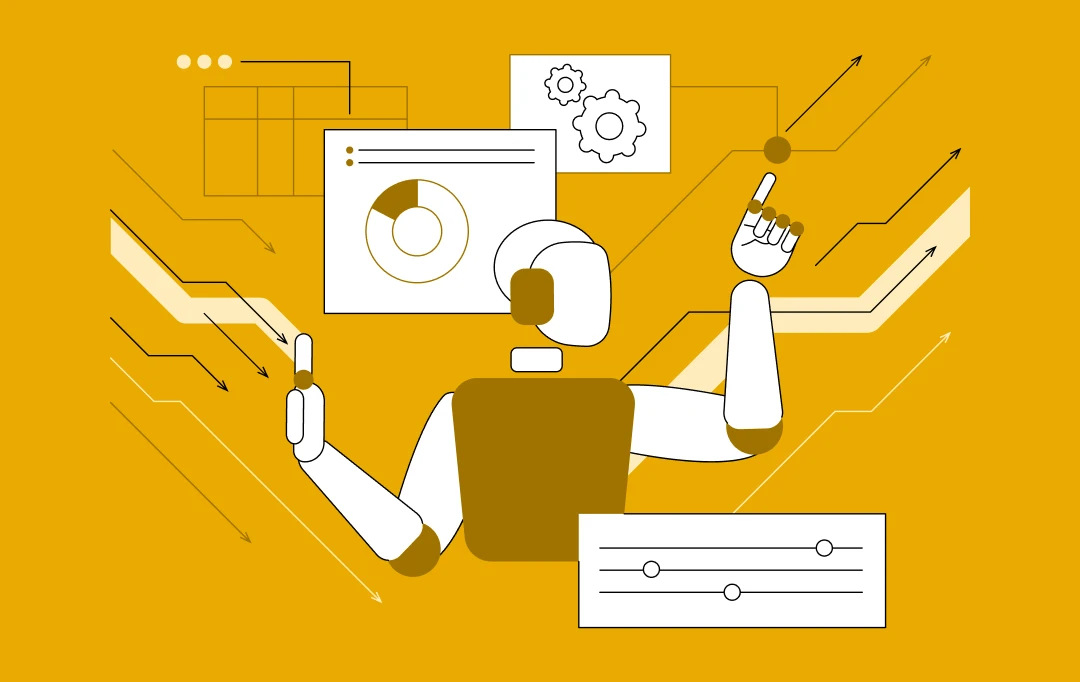
How to Integrate AI with EHR/EMR Systems for Streamlined Healthcare Operations
Key takeaways: Not adopting AI in EHR/EMR today risks falling behind. AI streamlines EHR workflows, cutting clinical and admin delays. Real-world hospitals are already seeing faster, smarter care with AI. Seamless AI integration needs system checks, data prep, and training. AI in EHR tackles real challenges like bias, cost, and compliance. Custom AI integration costs…
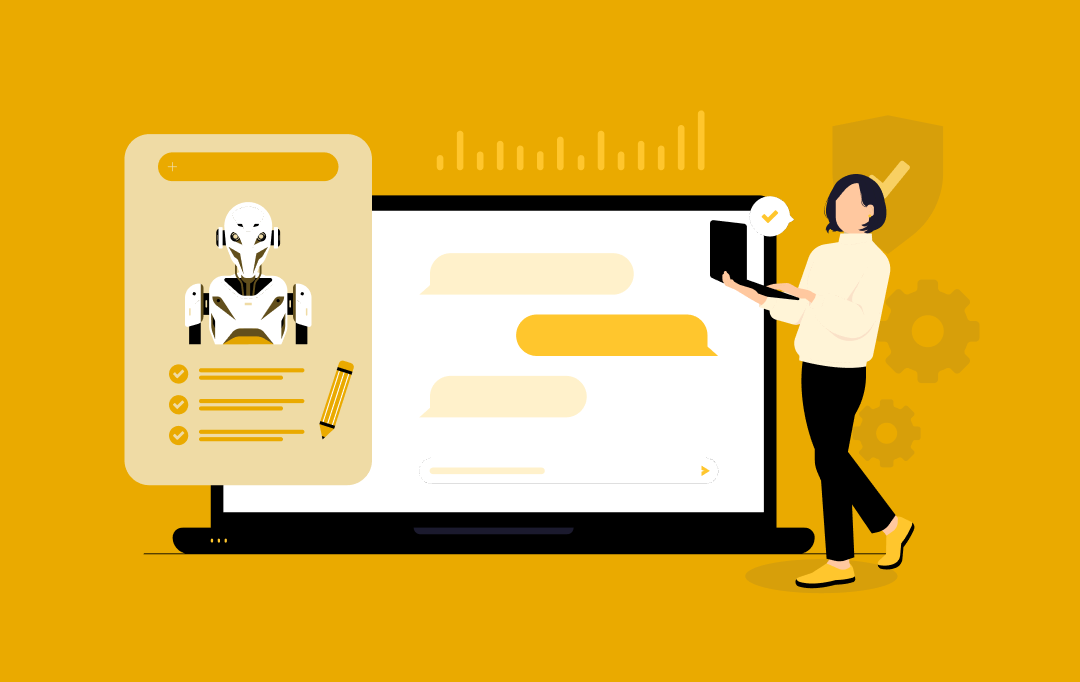
AI Agent-Driven UIs: Replacing App Menus and Buttons
Key takeaways: Challenge: Static menus and buttons also become outdated because people are frustrated by limited, multi-stage navigation. Solution: The AI Agent interacts with the user through a friendly UI that does not require cludgy menus but conversational and context-sensitive navigation. The Way AI Agents Work: AI agents establish a basis of natural language understanding,…
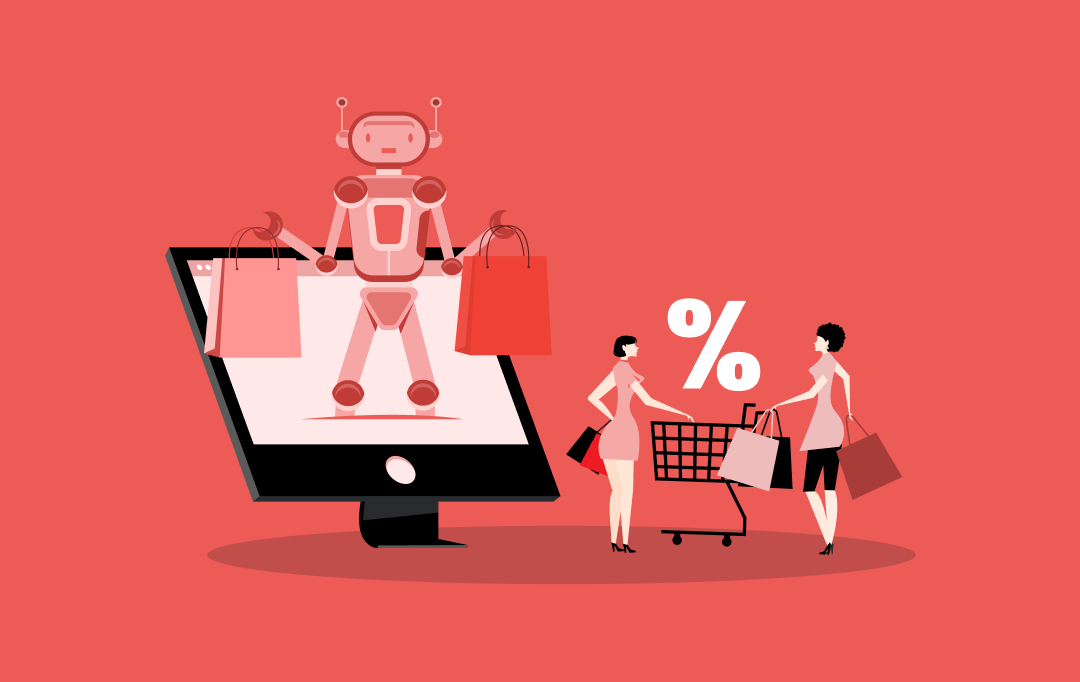
10 Use Cases and Benefits of How AI Agents Are Revolutionizing the Retail Industry
Key takeaways: AI agents in the retail industry are revolutionizing businesses by enhancing customer experience and streamlining operations. From personalized recommendations to predictive analytics, AI offers tangible benefits like increased conversions and reduced costs. AI adoption can lead to scalable growth and a competitive edge in the retail industry. Retailers must consider data strategies, talent…

















